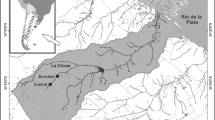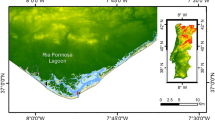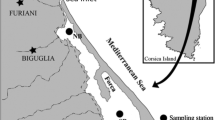Abstract
The effects of nutrient additions upon the epilithic diatom communities and the algal standing crop were investigated in the oligotrophic, softwater Lake Piccolo Naret, situated in the Swiss alps. Nutrient-diffusing flower pot substrates were filled with either N (0.15 mol NaNO3), P (0.015 mol Na2HPO4) or C (0.15 mol NaHCO3) or combinations of them. Twenty-five pots representing eight treatments were placed into the lake in July 1991 and sampled after 42 days of exposure.
On the surfaces of all pots containing P we measured higher algal biomasses as on the control pots. The chlorophyll-a maximum of 12.9 µg cm− 2 was obtained on NPC pots (0.47 µg cm− 2 on control pots). On pots with P, NP or NPC supply high amounts of green algae were detected, also reflected in an increased chl-b/chl-c ratio related to the controls which showed algal communities dominated by diatoms.
The diatom communities on the control pots as well as on the pots with N, P and NP had a structure similar to the epilithic community in Lake Piccolo Naret (dominance identity > 58 %). However, the community structures of the diatoms from pots with C addition (C, NC, PC and NPC) differed considerably. This is discussed in view of the cell densities of dominant diatom species. For further comparisons the results of two additional high-mountain lakes are used. By means of a cluster analysis it could be shown that epilithic diatom communities were considerably influenced by C addition, while N and P supply were of minor importance.
Similar content being viewed by others
References
American Public Health Association, 1975. Standard Methods for the examination of water and wastewater. 14th edn. American Public Health Association, Washington D. C., 1193 pp.
Charles, D. F., 1985. Relationships between surface sediment diatom assemblages and lakewater characteristics in Adirondack lakes. Ecology 66: 994–1011.
Charles, D. F., R. W. Batterbee, I. Renberg, H. van Dam & J. P. Smol, 1989. Paleoecological analysis of lake acidification trends in North America and Europe using diatoms and chrysophytes. In S. A. Norton, S. E. Lindberg & S. L. Page (eds), Acidic precipitation. Soil, aquatic processes, and lake acidification, Vol. 4. Springer, N.Y., 293 pp.
DEV, 1981. Deutsche Einheitsverfahren zur Wasser-, Abwasser- und Schlamm-Untersuchung. Verlag Chemie, Weinheim.
Dixit, S. S., J. P. Smol, J. C. Kingston & D. F. Charles, 1992. Diatoms: Powerful indicators of environmental change. Environ. Sci. Technol. 26: 22–32.
Douglas, B., 1958. The ecology of the attached diatoms and other algae in a small stony stream. J. Ecol. 46: 295–322.
Engelberg, K., 1987. Die Diatomeen-Zönosen in einem Mittelgebirgsbach and die Abgrenzung jahreszeitlicher Aspekte mit Hilfe der Dominanz-Identität. Arch. Hydrobiol. 110: 217–236.
Fairchild, G. W. & A. C. Everett, 1988. Effects of nutrient (N, P, C) enrichment upon periphyton standing crop, species composition and primary production in an oligotrophic softwater lake. Freshwat. Biol. 19: 57–70.
Fairchild, G. W. & R. L. Lowe, 1984. Artificial substrates which release nutrients: Effects on periphyton and invertebrate succession. Hydrobiologia 114: 29–37.
Fairchild, G. W., R. L. Lowe & W. B. Richardson, 1985. Algal periphyton growth on nutrient-diffusing substrates: An in situ bioassay. Ecology 66: 465–472.
Fairchild, G. W. & J. W. Sherman, 1990. Effects of liming on nutrient limitation of epilithic algae in an acid lake. Wat. Air Soil Pollut. 52: 133–147.
Fairchild, G. W. & J. W. Sherman, 1992. Linkage between epilithic algal growth and water column nutrients in softwater lakes. Can. J. Fish. Aquat. Sci. 49: 1641–1649.
Fairchild, G. W., J. W. Sherman & F. W. Acker, 1989. Effects of nutrient (N, P, C) enrichment, grazing and depth upon littoral periphyton of a softwater lake. Hydrobiologia 173: 69–83.
Flower, R. J. & V. J. Jones, 1989. Taxonomic descriptions and occurences of new Achnanthes taxa in acid lakes in the U. K. Diatom Res. 4: 227–239.
Hütter, L. A., 1990. Wasser und Wasseruntersuchung, 4th edn. Otto Salle Verlag, Frankfurt am Main, 511 pp.
Jeffrey, S. W. & G. F. Humpfrey, 1975. New spectrophotometric equations for determining chlorophylls a, b, cl and c2 in higher plants, algae and natural phytoplankton. Biochem. Physiol. Pflanzen 167: 191–194.
Krammer, K. & H. Lange-Bertalot, 1986–1991. Bacillariophyceae: Süsswasserflora von Mitteleuropa, 2 (1–4). Fischer Verlag, Stuttgart, 4 Vols.
Linder, A. & W. Berchtold, 1979. Elementare statistische Methoden. Birkhäuser Verlag, Basel, 248 pp.
Marcus, M. D., 1980. Periphytic community response to chronic nutrient enrichment by a reservoir discharge. Ecology 61: 387–399.
Moss, B., 1973. The influence of environmental factors on the distribution of freshwater algae: An experimental study. II The role of pH and the carbondioxide-bicarbonate system. J. Ecol. 61: 157–177.
Redfield, A. C., 1958. The biological control of chemical factors in the environment. Am. Scient. 46: 205–221.
Renkonen, O., 1938. Statistische-ökologische Untersuchungen über die terrestrische Käferwelt der finnischen Bruchmoore. Ann. Zool. Soc. Zool. Bot. Fenn. Vanamo 6.1: 1–231.
Round, F. E., 1990. The effect of liming on the benthic diatom populations in three upland Welsh lakes. Diatom Res. 5: 129–140.
Salden, N., 1978. Beiträge zur Oekologie der Diatomeen (Bacillariophyceac) des Süsswassers. Dechania-Beih. 22: 1–238.
Schanz, F., 1984. Chemical and algological characteristics of five high mountain lakes near the Swiss National Park. Verh. int. Ver. Limnol. 22: 1066–1070.
Schanz, F., 1987. Beurteilung des Einflusses von sauren Niederschlägen auf das Macun-Gebiet im Unterengadin (Schweiz). Verh. Ges. Oekol. 15: 249–255.
Sheldon, R. B. & C. W. Boylen, 1975. Factors affecting the contribution by epiphytic algae to the primary production of an oligotrophic freshwater lake. Appl. Microbiol. 30: 657–667.
Smith, M. A., 1990. The ecophysiology of epilithic diatom communities of acid lakes in Galloway, southwest Scotland. Phil. Trans. R. Soc. Lond. B 327: 251–256.
Smol, J. P., 1987. Methods in quarternary ecology 1. Freshwater algae. Geosci. Can. 14: 208–217.
Stevenson, R. J., R. Singer, D. A. Roberts & C. W. Boylen, 1985. Patterns of epipelic algal abundance with depth, trophic status and acidity in poorly buffered New Hampshire lakes. Can. J. Fish. aquat. Sci. 42: 1501–1512.
Stockner, J. G. & F. A. J. Armstrong, 1971. Periphyton of the Experimental Lakes Area, Northwestern Ontario. J. Fish Res. Bd Can. 28: 215–229.
Straub, F., 1981. Utilisation des menbranes filtrantes en téflon dans la préparation des diatomées épilithique. Comptes rendus du 2e colloque de l'ADLAF. Cryptogamie. Algologie 2: 153.
Stumm, W. & J. J. Morgan, 1981. Aquatic chemistry. 2nd edn. Wiley & Sons, New York, 780 pp.
Turner, M. A., M. B. Jackson, L. D. Findlay, R. W. Graham, E. R. DeBruyn & E. M. Vandermeer, 1987. Early responses of periphyton to experimental lake acidification. Can. J. Fish. aquat. Sci. 44: 135–149.
Turner, M. A., E. T. Howell, M. Summerby, R. H. Hesslein, D. L. Findlay & M. B. Jackson, 1991. Changes in epilithon and epiphyton associated with experimental acidification of a lake to pH 5. Limnol. Oceanogr. 36: 1390–1405.
Wathne, B. M., R. Mosello, A. Henriksen & A. Marchetto, 1990. Comparison of the chemical characteristics of mountain lakes in North and South Europe. In M. Johanessen, R. Mosello & H. Barth (eds), Acidification processes in remote mountain lakes. E. Guyot SA, Brussels: 41–58.
Wildi, O. & L. Orlóci, 1990. Numerical exploration of community patterns. SPB Academic Publishing, The Hague, 124 pp.
Author information
Authors and Affiliations
Rights and permissions
About this article
Cite this article
Niederhauser, P., Schanz, F. Effects of nutrient (N, P, C) enrichment upon the littoral diatom community of an oligotrophic high-mountain lake. Hydrobiologia 269, 453–462 (1993). https://doi.org/10.1007/BF00028043
Issue Date:
DOI: https://doi.org/10.1007/BF00028043




